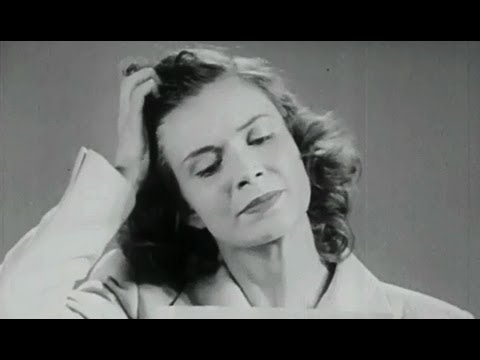more at
‘Demonstrates how self-confidence and right attitudes are necessary to good health…
Reveals how attitudes toward seemingly unrelated happenings, such as failure to get a promotion, can prevent an individual from doing his best and even cause physical illness. For high school, college, and adult groups.
Ken Smith sez: This film tells the story of “Marvin Baker” — “an average fellow from an average home in an average town” — who learns that having an “attitude” can make him sick and a failure in life. Happily, by the end of the film, Marv has adopted a “better perspective” and makes the first team in basketball. Watch for the montage of people with bad attitudes, including a woman with giant shoulders and scary eyebrows, and a fat-faced man with a “tick.”
Stock shots:
Doctor makes house visit; doctor in smock; nervous tic; hands on a keyboard; boy shoots basketball; headaches’
NEW VERSION with improved video & sound:
Public domain film from the Prelinger Archives, slightly cropped to remove uneven edges, with the aspect ratio corrected, and mild video noise reduction applied.
The soundtrack was also processed with volume normalization, noise reduction, clipping reduction, and/or equalization (the resulting sound, though not perfect, is far less noisy than the original).
Wikipedia license:
An attitude is an expression of favor or disfavor toward a person, place, thing, or event (the attitude object). Prominent psychologist Gordon Allport once described attitudes “the most distinctive and indispensable concept in contemporary social psychology.”. Attitude can be formed from a person’s past and present. Attitude is also measurable and changeable as well as influencing the person’s emotion and behavior.
In lay language, attitude may refer to the distinct concept of mood, or be especially synonymous with teenage rebellion…
Definitions of attitude
An attitude can be defined as a positive or negative evaluation of people, objects, event, activities, ideas, or just about anything in your environment, but there is debate about precise definitions. Eagly and Chaiken, for example, define an attitude “a psychological tendency that is expressed by evaluating a particular entity with some degree of favor or disfavor.” Though it is sometimes common to define an attitude as affect toward an object, affect (i.e., discrete emotions or overall arousal) is generally understood to be distinct from attitude as a measure of favorability.
This definition of attitude allows for one’s evaluation of an attitude object to vary from extremely negative to extremely positive, but also admits that people can also be conflicted or ambivalent toward an object meaning that they might at different times express both positive and negative attitude toward the same object. This has led to some discussion of whether individual can hold multiple attitudes toward the same object.
Whether attitudes are explicit (i.e., deliberately formed) versus implicit (i.e., subconscious) has been a topic of considerable research. Research on implicit attitudes, which are generally unacknowledged or outside of awareness, uses sophisticated methods involving people’s response times to stimuli to show that implicit attitudes exist (perhaps in tandem with explicit attitudes of the same object). Implicit and explicit attitudes seem to affect people’s behavior, though in different ways. They tend not to be strongly associated with each other, although in some cases they are. The relationship between them is poorly understood.
Jung’s definition
Attitude is one of Jung’s 57 definitions in Chapter XI of Psychological Types. Jung’s definition of attitude is a “readiness of the psyche to act or react in a certain way” (Jung, [1921] 1971:par. 687). Attitudes very often come in pairs, one conscious and the other unconscious…

